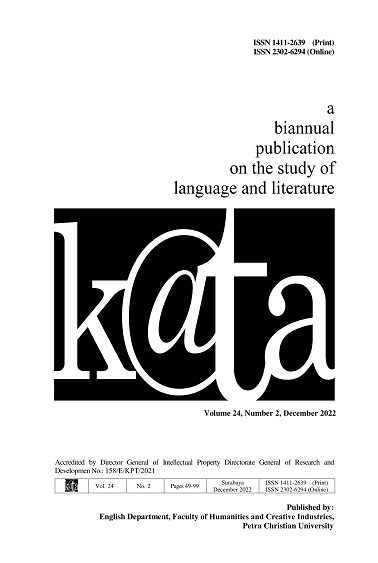Conceptual Metaphor of Different Conventionality Levels from the Perspectives of Translatability Assessment and Translation Strategies
Abstract
This study examines the Conceptual Metaphor Theory from an innovative perspective: translatability and translation strategy. The experiment recruited 239 undergraduate students of different translation training to evaluate the translatability of twelve sentences of different metaphor types before translating them into Vietnamese. Additionally, this study examines how students deal with metaphorical mapping images as well as grammatical and lexical refining attempts. The factorial ANOVA results (p=.02) indicate that the effect of metaphor types on translatability levels is conditional on translation training levels, despite the fact that the main effect is on metaphor types, not translation skill. Besides, twelve in-depth strategies to deal with the source sentences are identified, establishing a new model for metaphorical translation strategy. Chi-square analysis reveals associations between translation training levels and strategies (p<.01); and between metaphor types and strategies (p<.01). This study argues for the possibility that translation could be considered among conceptual metaphor's cognitive mechanisms.
Downloads
References
Ahrens, K. (2002). When love is not digested: Underlying reasons for source to target domain pairings in the contemporary theory of metaphor. In Proceedings of the first cognitive linguistics conference (pp. 273-302). Taipei: Cheng-Chi University.
Ahrens, K. (2010). Mapping principles for conceptual metaphors. Researching and applying metaphor in the real world, 26, 185-208.
Ahrens, K., & Zeng, W. H. (2022). Referential and evaluative strategies of conceptual metaphor use in government discourse. Journal of Pragmatics, 188, 83-96.
Al-Hasnawi, A. R. (2007). A Cognitive Approach to Translating Metaphors. Translation Journal, 11(3).
de Saint Preux, A. D., & Blanco, O. M. (2021). The power of conceptual metaphors in the age of pandemic: The influence of the WAR and SPORT domains on emotions and thoughts. Language & Communication, 81, 37-47.
Evan, V. and Green, M. (2006). Cognitive Linguistics: An Introduction. Mahwah, NJ: Laurence Erlbaum Associates.
Fernandes, K. (2021). Translating English WOMAN IS AN ANIMAL metaphors: Spanish native speakers’ associations with novel metaphors. Linguistik Online, 108(3), 33–66. https://doi.org/10.13092/lo.108.7797
Fernández, S. (2011). Translation Studies and the Cognitive Theory of Metaphor. Review of Cognitive Linguistics, 9, 262-279.
Hemphill, C. (2019). Dressing for Spiritual Battle and Other Challenges: Translating Passages with Underlying Conceptual Metaphors. Journal of Translation, 15, 23-34.
Iranmanesh, A., & Kulwindr Kaur, G. S. (2010). A cognitive approach and the translation strategies used in the subtitling of metaphors in three American movies. In Proceedings of the International Conference on Translation and Multiculturalism: Found in Translation a common voice in a multicultural world. Kuala Lumpur, Malaysia: University of Malaya. Retrieved November (Vol. 18, p. 2013).
Kovecses, Z. (2005). Metaphor in Culture: Universality and Variation. Cambridge: Cambridge University Press.
Lai, V.T., Curran, T., & Menn, L. (2009). Comprehending conventional and novel metaphors: an ERP study. Brain Research, 1284, 145-155.
Lakoff, G. (1993). The contemporary theory of metaphor. The contemporary theory of metaphor, In: Ortony, Andrew (Ed.), Metaphor and Thought, 2nd ed. Cambridge, Cambridge University Press.
Lakoff, G. (2016). Language and emotion. Emotion Review, 8(3), 269-273.
Lakoff, G. & Johnson, M. (1980). Metaphors we Live by. Chicago: University of Chicago Press.
Lakoff, G. & Johnson, M. (1999). Philosophy in the Flesh. New York: Basic Books.
Lakoff, G., & Turner, M. (2009). More than cool reason: A field guide to poetic metaphor. University of Chicago press.
Mandelblit, N. (1995). The Cognitive View of Metaphor and its Implications for Translation Theory. Translation and Meaning, Part 3 (483-495). Maastricht: Universitaire Press.
Massey, G. & Ehrensberger-Dow, M. (2017). Translating Conceptual Metaphors: The Processes of Managing Interlingual Asummetry. Research in Language, 15, 174-189.
Nguyen, V. T. (2018). A Comparative Analysis on Metaphoric Strategies in Presidential Inaugurals of Barack Obama and Donald Trump. Studies in Linguistics, 48, 157-179.
Nguyen, V. T. (2019). Conceptual Correspondences in Source – Target Domain Pairings: A Test of the Conceptual Mapping Model in Vietnamese Language. Paper presented at the 2019 International Conference on Vietnamese and Taiwanese Studies, Tainan, Taiwan.
Qiu, H., Watson, B., & Tay, D. (2022). Metaphors and trauma: An image schematic analysis of symptom-specific metaphors. Lingua, 103244.
RewiÅ›-ÅÄ™tkowska, A. (2019). The linguistic, conceptual and communicative dimension of metaphor: A corpus study of conversational Polish. Journal of Pragmatics, 153, 80-91.
Sanders, (2016). Theology in the Flesh: How Embodiment and Culture Shape the Way We Think about Truth, Morality, and God. Minneapolis, MN: Fortress Press.
Schaffner, C. (2004). Metaphor and Translation: Some Implications of a Cognitive Approach. Journal of Pragmatics, 36, 1253-1269.
Sjørup, A. C. (2013). Cognitive effort in metaphor translation: An eye-tracking and key-logging study. Frederiksberg: Copenhagen Business School (CBS).
Taheri-Ardali, M., Bagheri, M., & Eidy, R. (2013). Towards a New Model to Metaphor Translation: A Cognitive Approach. Iranian Journal of Translation Studies, 11(41), 35-52.
Tirkkonen-Condit, S. (2002). Metaphoric Expressions in Translation Processes. Across Languagues and Culture, 3(1), 101-116.
Tobias, S. (2015). Traversing Textual Terrains: The Translation of Metaphor in “Rashomonâ€. Translation Review, 92(1), 8-22.
Toury, G. (1995). Descriptive Translation Studies and Beyond. Amsterdam: John Benjamins.
Tseng, M. Y., & Chuang, S. W. (2022). Metaphor and creativity in the act of making her heart flutter: Toward a cognitive-emotive perspective. Journal of Pragmatics, 191, 194-210.
van Poppel, L. (2020). The relevance of metaphor in argumentation. Uniting pragma-dialectics and deliberate metaphor theory. Journal of Pragmatics, 170, 245-252.
Zhang, L., Atari, M., Schwarz, N., Newman, E. J., & Afhami, R. (2022). Conceptual metaphors, processing fluency, and aesthetic preference. Journal of Experimental Social Psychology, 98, 104247.
Zheng, J. (2015). Translation of Metaphors in Business English from a Cognitive Perspective. International Journal of English Linguistics, 5(2), 132-138.

This work is licensed under a Creative Commons Attribution 4.0 International License.
![]() This work is licensed under a Creative Commons Attribution License
This work is licensed under a Creative Commons Attribution License




.png)
.png)

.png)












